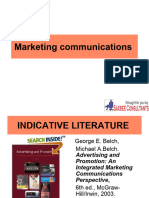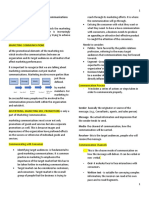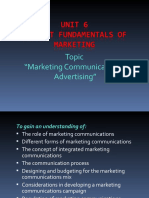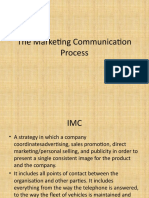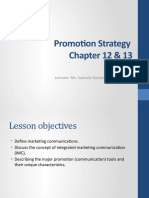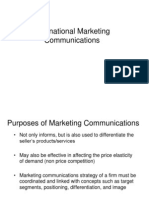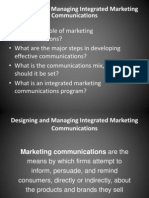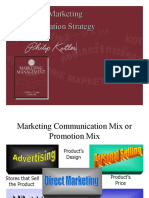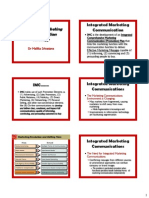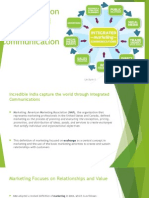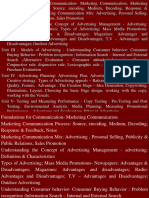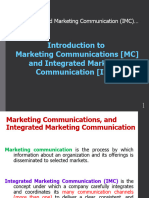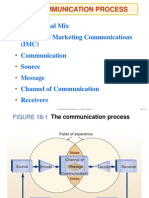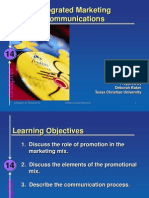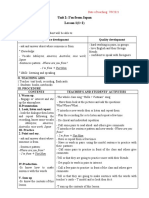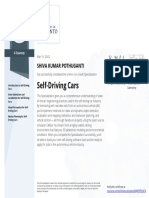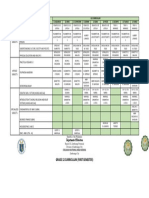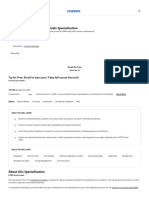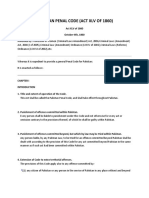Marketing communications
MIB Program
Aliona N. Andreyeva
Fall Semester, 2009-2010
INDICATIVE LITERATURE
George E. Belch,
Michael A.Belch.
Advertising and
Promotion: An
Integrated Marketing
Communications
Perspective,
6th ed., McGraw-
Hill/Irwin, 2003.
8
th
ed., 2008.
INDICATIVE LITERATURE
Kenneth E.Clow,
Donald Baack.
Integrated
Advertising,
Promotion, and
Marketing
Communications,
Second Edition. 1998.
4
th
ed., 2009.
INDICATIVE LITERATURE
Phillip J.Kitchen.
Marketing
Communications:
Principles and
Practice. Int.
Thomson Business
Press, 1998.
Marketing communications:
principles, basic elements, instruments
Definitions of marketing communications.
Basic instruments of MarCom.
Process of communication and its basic elements.
Evolution of marketing communications concepts.
World discussion on integrated marketing
communications.
Principles of effective marketing communications:
target audience, choice of medium, message,
budgeting, monitoring and control.
MARKETING
Marketing is
the activity, set of institutions, and processes
for creating, communicating, delivering, and
exchanging
offerings
that have value for customers, clients,
partners, and society at large.
Approved October 2007
(AMA, www.marketingpower.com)
COMMUNICATION
1. an act or instance of transmitting;
2. a verbal or written message;
3. a process by which information is exchanged between
individuals through a common system of symbols,
signs, or behavior; also : exchange of information;
4. a system (as of telephones) for communicating: a
system of routes for moving troops, supplies, and
vehicles;
5. a technique for expressing ideas effectively (as in
speech); the technology of the transmission of
information (as by print or telecommunication)
(Meriam-Webster dictionary, www.m-w.com)
MARKETING COMMUNICATIONS
A process by which product information is
transmitted to the target audience
PRODUCT
INFORMATION
TARGET AUDIENCE
MARKETING MIX
PRODUCT
Product characteristics,
options, assortment, brand
name, packaging, quantity,
factory guarantee
PLACE
Different types of distribution
channels, density of the distribution
system, trade relation mix (policy of
margins, terms of delivery, etc),
merchandising advice
PRICE
List price, usual terms of
payment, usual discounts,
terms of credit, long-term
saving campaigns
PROMOTION
Advertising
Sales promotion
Personal selling
PR
MarCom: MAIN OBJECTIVES
INFORMING
Product Launch
phase
Explanations of
Products
features & benefits
REMAINDING
Product
Sales Growth phase
Competitive
positioning
PURSUADING
Product Maturity phase
Applies to consumers memory
(brand specific)
TARGET
AUDIENCE
MarCom Mix
Communication
Program
Advertising
PR
Sales
Promotions
Event
Marketing
POS
materials
Merchandising
Sponsorship
Product
placement
New
Media
Internet
Mobile
Communications
BASIC INSTRUMENTS
ADVERTISING
SALES PROMOTION
PR
DIRECT
MARKETING
EXHIBITIONS
CORPORATE IMAGE
PERSONAL
SELLING
SPONSORSHIP
PACKAGING
POS MATERIALS
WORD-IN-MOUTH
INTERNET
PRODUCT
PLACEMENT
Communication Theory
SENDER
MESSAGE
RECIEVER
encoding
Channel MESSAGE
decoding
Barriers
or
Noise
FEEDBACK RESPONSE
SENDER
The party sending
the message to another party
Major parties in communication
MESSAGE
The set of messages
the sender sends
Major
communication tool
ENCODING
Putting through
into symbolic form
One of
communication function
CHANNEL
Communication channels
message is sent through
Major
communication tool
DECODING
The process by which receivers
assign meaning to the senders
transmitted symbols
One of
communication function
The party receiving
the message (audience)
RESEIVER
Major parties In communication
RESPONSE
Set of reactions following
exposure/reception of message
One of
communication function
NOISE (Un)planned static or distortion during process of communication
FEEDBACK
Part of response
transmitted back to the sender
One of
communication function
EVOLUTION OF MARKETING
COMMUNICATIONS CONCEPTS
MARKET
MEDIA &
COMMUNICATIONS
CONSUMERS
shift from mass
marketing and
product oriented
concepts (1950-60)
to
FOCUS ON
CONSUMER
DATA BASED MARKETING
INTERACTIVE COMMUNICATIONS
MEASURED RESULTS
INTEGRATED MARKETING
COMMUNICATIONS
A planning process
designed to assure
that all brand contacts
received by a customer or prospect
for a product, service, or organization
are relevant to that person and consistent
over time.
(AMA)
IMC Requirements
Awareness of audiences media habits
and preferences
Understanding of audiences knowledge
and beliefs about the product
Use of coordinated media blend linked to
a specific objective
Key is a single, coordinated message
and image thrust
IMC
Synergy
Better use of communication funds
Balancing the push and pull strategies
Improves the companys ability
to reach
the right consumer
at the right place
at the right time
with the right message
Push & Pull Strategy
push strategy
directs communication efforts at channel members
many products, such as business products, are
promoted with a push strategy, involving personal
selling and use of trade promotions
pull strategy
directs promotion at the end consumer
most consumer products would rely more heavily on a
pull strategy
where promotion is directed at the consumer to
stimulate demand
Producer
Wholesaler
Retailer Consumer
PUSH STRATEGY
Producer Wholesaler Retailer Consumer
Product flow Communication effort
PULL STRATEGY
What else is important?
Segmentation
Targeting
Positioning
SEGMENTATION
A market segment is basically
a set of individuals unique in
some way or the other
Sharing one or more common
characteristics
Having similar needs
Responding to market
conditions in the same manner
Have similar behavioural
patterns
May or may not be belonging to
the same community,
group or
niche
TARGETING
Selecting the target
audience (TA)
for whom your product or
service
is meant to be, most likely
based on
Age group
Likes and dislikes
Gender
Socio-economic factors
Geographic location
POSITIONING
refers to the image your
target audience has
regarding your product or
service as compared to your
competitors
It is all the more essential in
today's setup, where literally
no sector is devoid of an
oligopolistic setup
Primary, and in most cases,
the ONLY objective:
To highlight your
product's USP in the
most striking manner
PRINCIPLES OF EFFECTIVE
MARKETING COMMUNICATIONS
WHO?
WHERE?
WHAT?
HOW MUCH?
FORM
CHANNEL
PERIOD OF TIME
WHAT WAS IT?
Identifying the Target Audience
Choice of Communication Channel
Message
Budget
Communication program design
Monitoring & Evaluation
Identifying Target Audience
Image analysis:
Beliefs,
Ideas,
Attitudes,
Impressions & Actions
regarding an object
Choice of communication channel
CHANNELS
PERSONAL NON PERSONAL
ADVOCATE
EXPERT
SOCIAL
EVENTS
ATMOSPHERE
MEDIA
PRINT
BROADCAST
NETWORK
ELECTRONIC
DISPLAY
Design Message
Message content
Rational
Emotional
Moral
Message structure
One- Vs Two-sided arguments
Conclusion drawing
Order of Presentation
Design message
Message Source
Source credibility
Endorser
Message Format
The message has to be considered
depending on which media is going to be
used e.g. Layouts, props, models, music,
voice, etc.
Establishing Marketing
Communications Budget
Affordable Method
Percentage-of-Sales Method
Competitive Parity method
Objective-and-Task Method
Decisions on the
Marketing Communication Mix
Personal selling
direct presentation of a product to a prospective customer by a
representative of the selling organization
Advertising
A paid, impersonal mass communication with a clearly-identified
sponsor
Sales promotion
Demand-stimulating activity designed to supplement advertising and
facilitate personal selling
Public relations
A planned communication effort by an organization to contribute to
generally favourable attitudes and opinions toward an organization
and its products
Publicity
A special form of public relations that involves news stories about an
organization or its products
Measure
the Communications Results
Target audience is usually asked whether
they
recognize or
recall
the message
What else can influence
MarCom Mix
Type of product (service) consumer or
B2B
Stage of product life cycle
Level of consumer readiness to accept
product (service)
Promotion strategy (Push or Pull)
Competitors MarCom Mix
Financial resources
SUMMARY & KEY TERMS
MarCom as process
Linkage of Marketing Mix & MarCom Mix
Basic instruments of MarCom (13)
Communication Theory
IMC theory
Segmentation
Targeting
Positioning
Principles of MarCom efficiency

